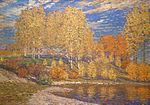Vilhelms Purvītis
Vilhelms Purvītis (born March 3, 1872 in the municipality of Zaube , Livonia Governorate ; † January 14, 1945 in Bad Nauheim , Germany ) was a Latvian landscape painter.
Life
In 1886 the parents' family moved to the Vitebsk Governorate , where the father had bought a water mill. In addition to working in the mill, Purvītis was able to attend a high school in Drissa for a year . Here his drawing talent was particularly encouraged by one of the teachers. He spent another year as an apprentice in a factory near Smiltene . After the renovation of his parents' mill, Purvītis was able to fulfill his great wish in 1890: thanks to a small grant from the local count, he traveled to St. Petersburg and, because of his work, was admitted to the art academy without a higher educationrecorded. The Latvian students of St. Petersburg met regularly as a group "Rūķis". Friendships with the painters Ādams Ālkšnis, Jānis Valters and the somewhat older Janis Rozentāls date from this period. In addition to the intensive study, commissioned work such as tsar portraits were made for a living. During this time, the art academy turned to realism . Purvītis decided to become a landscape painter and was accepted into the master class of Archip Ivanovich Kuindschi in 1895 . In 1897 he received a gold medal for his thesis.
In the following years Purvītis traveled several times to Western Europe. He gained recognition at exhibitions in Paris , Lyon and various German cities. In St. Petersburg he sent the spring exhibitions and was part of the Mir Iskusstwa group . On April 20, 1903, he married Augusta Caroline Lydia Stellmacher in Mitau. After 1903, however, he turned away from the international art business and concentrated on his now leading position in Riga. Together with Jānis Valters, who was now related by marriage and who had married Augusta Caroline Lydia Stellmacher's sister, he got caught between social lines during the revolution of 1905 . As members of the art association supported by the German-Baltic upper class, both refused to sign a petition to the tsar. This led to a break with most of the Latvian intelligentsia. As a result, Purvītis gave up his independent artistic life, withdrew from public life and taught for three years at a German secondary school in Reval . He did not return until 1909 when he was appointed director of the Riga Art School. When this school was opened to Latvian students, their share of the student body increased from 1% to 70% by 1914. When the World War I fronts approached the city in 1915 , the art school and all staff were evacuated to St. Petersburg. Due to illness, Puvītis and his family were allowed to leave for Norway in 1917 and spent a year in a sanatorium in Lillehammer . In autumn 1918 he returned to Riga. In early 1919 he became director of the Art Museum and the newly founded Latvian Art Academy . He also received an architecture professorship at the Latvian University.
As director of the academy, Purvītis had to face resistance at first, as his style was considered out of date. However, he achieved an orientation towards realism and had many students who continued his style. He organized many exhibitions of Latvian art abroad. Purvītis presented his own works only sparsely, although new works were constantly being created alongside teaching. In 1934 he lost his position as director of the art academy, but continued his master workshop until 1944. In 1942 another major exhibition of his works took place. In October 1944 he went to Germany before the advancing Red Army, where he died in a sanatorium in Bad Nauheim in 1945 .
plant
Purvītis immersed himself in his landscape paintings especially in the native nature of Latvia. Early focus was on early spring and the appearance of snow. In later years he took over influences from Impressionism , Art Nouveau , Post-Impressionism and Expressionism .
Many of his paintings disappeared during the Russian Civil War . Purvītis repainted these in the 1920s on the basis of reproductions and from memory. During the Second World War he stored the majority of his thousands of works in Jelgava , where they were lost in air raids in the summer of 1944.
literature
in order of appearance
- Waldemar von Mengden: The Salon of the Rigaschen Kunstverein. A review. In: Baltic Monthly. Vol. 47 (1905), pp. 101-121.
- Roderich von Engelhardt: Wilhelm Purwit. A Latvian artist. In: Heimatstimmen. A Baltic yearbook. Volume 5, Kluge, Reval / Hartmann, Leipzig 1912, pp. 184-200.
- Visvaldis Pengerots: Purvītis, Vilhelms . In: Hans Vollmer (Hrsg.): General lexicon of fine artists from antiquity to the present . Founded by Ulrich Thieme and Felix Becker . tape 27 : Piermaria – Ramsdell . EA Seemann, Leipzig 1933, p. 466-467 .
- Tatjana Kačalova: Vilhelms Purvītis. Liesma, Riga 1971 (Latvian).
- Valda Cerina: Vilhelms Purvitis as a landscape painter from 1890 to 1910. Self-published, Riga 2018, ISBN 978-9934-19-510-5 .
Web links
Individual evidence
- ↑ Tatjana Kačalova: vilhelms purvītis. P. 10.
- ↑ Tatjana Kačalova: vilhelms purvītis. P. 13.
- ↑ Tatjana Kačalova: vilhelms purvītis. P. 21.
- ↑ Latvian State Historical Archives / Latvijas Valsts vēstures arhīvs (LVVA). 235.14.175, Bl. 12v.
- ↑ Tatjana Kačalova: vilhelms purvītis. P. 55.
- ↑ Tatjana Kačalova: vilhelms purvītis. P. 91.
| personal data | |
|---|---|
| SURNAME | Purvītis, Vilhelms |
| ALTERNATIVE NAMES | Purvit, Wilhelm |
| BRIEF DESCRIPTION | Latvian landscape painter |
| DATE OF BIRTH | March 3, 1872 |
| PLACE OF BIRTH | Magic |
| DATE OF DEATH | January 14, 1945 |
| Place of death | Bad Nauheim |





